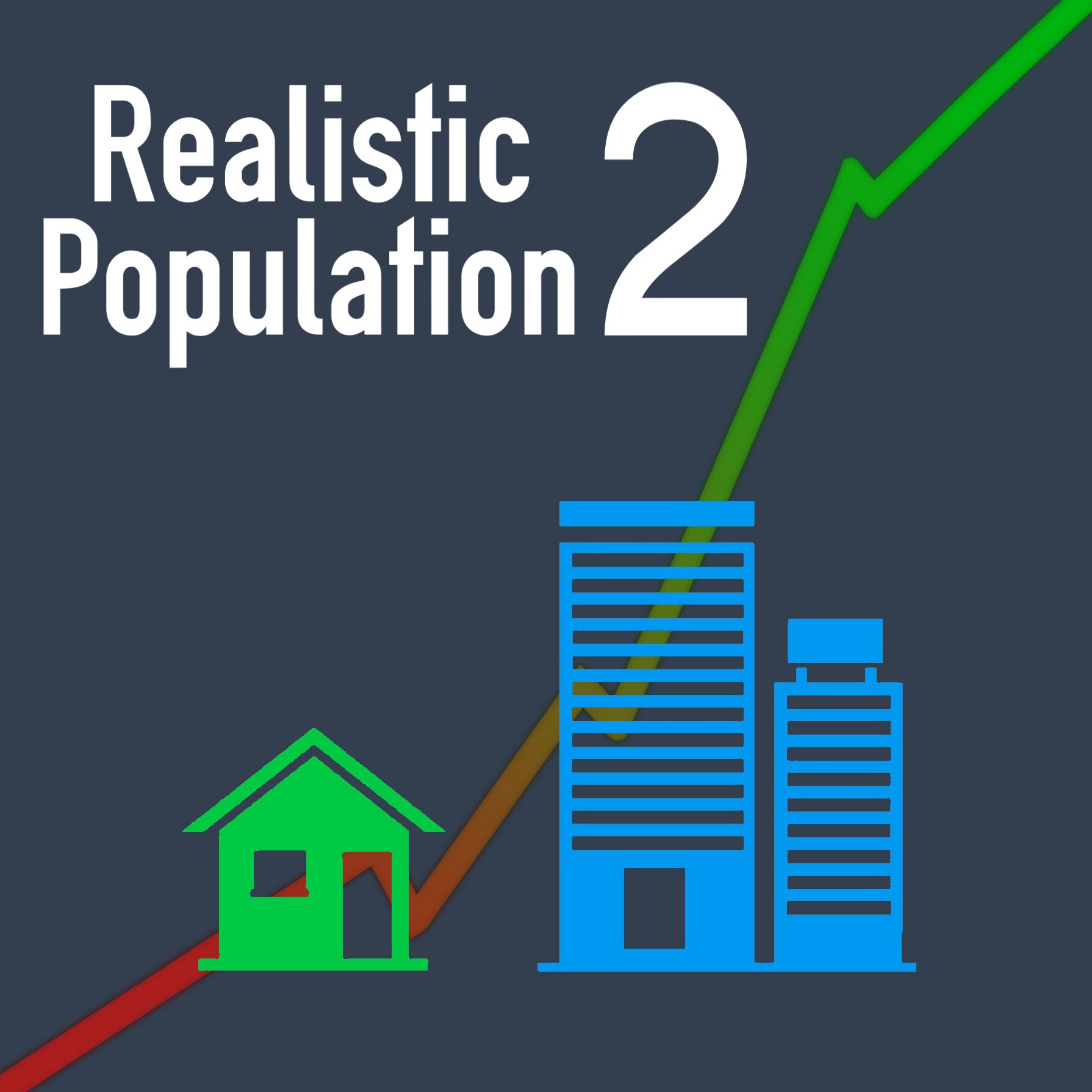Realistic Population 2 2.2.3

Key features:
- Provides a more realistic simulation and gameplay experience
- Realistic calculatrion of building populations – no more single suburban houses with half-a-dozen families and tall apartment buildings only containing a ridiculously small number of households
- More realistic city activity – no more empty downtowns because all your office buildings have only a handful of workers
- Makes buildings more accurately reflect real-world capacities
- Tax revenue is more realistically affected by land values
- Production and consumption rates made more realistic
- Enables cities to evolve, behave, and grow more realistically
- Provides more varied challenges and meaningful decisions around population density and required supporting infrastructure
Formerly ‘Realistic Population Revisited’, the official continuation of Whitefang Greytail’s Realistic Population and Consumption mod, this has been rebranded to ‘Realistic Population 2’ with the 2.0 update to better reflect the significant changes that have been made.
Figures and calculations can be easily changed, and entire features can be enabled or disabled. Be sure to check out the mod’s options panel (referring to the wiki linked above for detailed information).
This mod changes the numbers of households and jobs in buildings to more accurately reflect real-world values. Detached suburban housing will typically only support one family, while high-density residential buildings will have a number of households calculated based on the size of the building.
Office buildings and other employers support significantly more workers than the very low base game numbers, resulting in a much more realistic ratio of residential to commercial, industrial, and office buildings, and enables the natural evolution of more realistic downtowns and suburbs.
Employment education level requirements are also changed to more accurately reflect real-world requirements and to help address some of the base game’s shortcomings in this area. Office jobs are more heavily focussed towards your college graduates, and commercial and industrial jobs will require a higher ratio of high-school leavers than in the base game. This requires a more realistic level of investment in your education infrastructure.
Production of goods, water and electricity consumption, garbage accumulation, and building income have all been tweaked accordingly.
Tax income is now affected by land values. Raising land value, now increases your tax income.
These changes make decisions around density, zoning, and infrastructure more meaningful and more akin to the real-world tradeoffs. Low-density housing will provide lower population density than in the base game, meaning that sprawling suburbs will have more of their real-life downsides. Higher-density areas will have much greater population and job density than in the base game, meaning that you’ll need to ensure that you have the appropriate transportation infrastructure in place to support this density.
Ideally used in conjunction with Lifecycle Rebalance Revisited, but also works standalone. If you’re using the Industries DLC, the Rebalanced Industries Revisited mod is strongly recommended (but not required).
By default, all low density residential buildings are set to have only one household unless this is overridden in the building’s settings.
For workplaces, schools, and high density residential buildings, the number of jobs/households/student places is determined by the physical size of the building and the usage of real-life conversion and density factors. Power and water consumption values are based of the real-world values of Perth, Western Australia and scaled for the game.
Version 2.0 also implements student capacity calculatons for schools. These can be disabled or changed via the mod’s options panel (requires restart).
Athough this mod doesn’t touch demand (Residential/Commercial/Industrial) directly, the changed game balance means you might see some different demand patterns than you’re used to with the vanilla game, especially with industrial demand. See this page on the wiki[github.com] for more details.
Due to the significant changes to the base game, this mod is best used for new games only. You can use it on an existing game, but be warned that it will significantly affect the balance of your city – most likely you’ll see significant abandonment of factories, shops and offices (due to their more realistic job numbers), your transport infrastructure may be overloaded in high-density areas, and you may have land value issues. Your city can be rebalanced with appropriate zoning and transportation adjustments.
New games started with this mod can follow a more natural progression from low to high density than in the base game, but note that use of space needs to be carefully managed through the early stages if you are sticking to the base game’s area unlocking progression, as the average city density when starting out with this mod will be lower than in the base game. You’ll may wish to hold off zoning much high-density until you’ve got some decent transportation infrastructure in place.
It’s recommended (but not required) to use "unlock all" when using this mod. This mod is (as its name suggests) for supporting more realistic cities; the vanilla game’s unlocking progression is designed as a tutorial mechanism for first-time players, and is neither realistic nor intended for more experienced players (it’s still possible to use the unlocking progression, but it will take more time and effort to reach certain milestones).
Mod configurationEverything this mod does configurable. Don’t like the default assumptions? Change them!
Information on how to change the mod’s settings is available on the wiki[github.com].
Obviously, huge amounts of credit to Whitefang Greytail, the creator of the original Realistic Population and Consumption Mod. In turn, that mod started out as a fork of Kundun’s PopBalanceMod.
This mod uses Harmony[github.com] version 2.2 by Andreas Pardeike via the Cities Harmony mod by boformer.
 [crowdin.com]
[crowdin.com]
Please leave a message below if you’d like me to add another language on CrowdIn.
Required items:
Click the title to search on this site.
Harmony 2.2.2-0 (Mod Dependency) — Steam Workshop
Revisions:
Old revisions of this mod are available below. Click the link to download.







